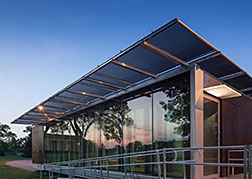- Number 400 |
- November 4, 2013
Solar Decathlon house continues to yield data

The Universlity of Tennessee's "Living Light "
solar house. (Photo courtesy of UT)
Staff and students at the University of Tennessee hope their innovations from last year’s Department of Energy Solar Decathlon benefit teams gearing up for the 2013 contest.
The biannual international competition, launched by DOE in 2002, challenges teams of students to design and build low- to zero-energy homes, learning about solar power and sustainable design along the way.
At UT, the “Living Light” house that placed eighth in the 2011 competition is still yielding research results and offering new teams a head start.
Led by James Rose, an architect and professor at UT, and colleague William Miller, adjunct professor in architecture and mechanical engineering and building scientist at DOE’s Oak Ridge National Laboratory, the UT team developed a new way to use double-skin facade technology.
By building each wall with two “skins” of glass and a 12-inch cavity between the two, the walls can flow air from outside the home into it or expel it back out. The innovation allows the home to harvest heat from the outdoors and supplement heating or cooling based on the season, while also providing fresh conditioned air to maintain indoor air quality.
After competing in Washington, D.C. and traveling to cities throughout the Southeast, the house was moved to the UT Gardens, where it is still used to gather data and provide an educational benefit to students and the visiting public, alike. UT does not plan to participate in the next decathlon, but does intend to continue their energy efficiency research.
“That’s the great thing about the Decathlon: it teaches students how to develop and use these buildings, but it also functions as a way to get the general public familiar with the technology” Rose said.
Miller, who works in ORNL’s Building Envelope Program, is keeping a close eye on the home, monitoring thermal analysis and solar performance on a long-term plan developed to evolve the technology in the future.
“We want to conduct research on the double facade to develop a computerized tool that could become useful for practitioners in the field for design of the application,” Miller said.
As solar technology improves, there has been a noticeable shift in the development of zero-energy buildings. The problem is that the general public has yet to be fully convinced of their necessity and the return they could make on their investment in years following.
“The home is a stepping stone to greater things. When we get new technology, it’s difficult to figure out exactly what impact it has on building science, but that is our goal,” Rose said.
UT is offering the general public free tours of the Living Light home on Wednesdays from 5:45 to 7 p.m., coinciding with the UT Farmer’s Market. Private tours can be arranged by contacting James Rose at jrose18@utk.edu.
More information on the home can be found here, provided by the University of Tennessee Science Forum: http://www.youtube.com/watch?v=wRlTK4mji3Y[Dylan Platz, 865.576.1946,
platzda@ornl.gov]
